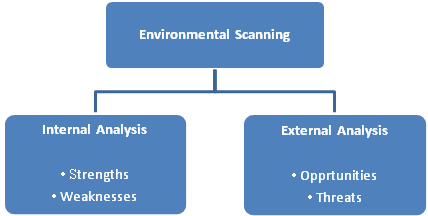SWOT ANALYSIS
Defination:
" A study undertaken by an organization to identify its internal strengths and weaknesses, as well as its external opportunities and threats."
What is a 'SWOT Analysis'
SWOT analysis is a process that identifies an organization's strengths, weaknesses, opportunities and threats. Specifically, SWOT is a basic, analytical framework that assesses what an entity (usually a business, though it can be used for a place, industry or product) can and cannot do, for factors both internal (the strengths and weaknesses) as well as external (the potential opportunities and threats)
Explanation:
Elements of a SWOT Analysis:
When using SWOT analysis, an organization needs to be realistic about its good and bad points. Analysis needs to be kept specific by avoiding gray areas and analyzing in relation to real-life contexts. For example, how do the organization’s products and services compare to those of competing firms? SWOT analysis should be short and simple, and should avoid complexity and over-analysis, as much of the information is subjective. Thus, companies should use it as a guide and not a prescription.
SWOT ANALYSIS FRAMEWORK

- Strengths: Describe what an organization excels at and separates it from the competition: things like a strong brand, loyal customer base, strong balance sheet, unique technology and so on.
- Weaknesses: Stop an organization from performing at its optimum level. They are areas where the business needs to improve to remain competitive: things like higher-than-industry average turnover, high levels of debt, an inadequate supply chain or lack of capital.
- Opportunities: Refer to favorable external factors that an organization can use to give it a competitive advantage.
- Threats: Refers to factors that have the potential to harm an organization. For example, a drought is a threat to a wheat-producing company, as it may destroy or reduce the yield of the crop. Other common threats include things like rising costs for inputs, increasing competition, tight labor supply and so on.
Advantages of SWOT Analysis:
SWOT Analysis is instrumental in strategy formulation and selection. It is a strong tool, but it involves a great subjective element. It is best when used as a guide, and not as a prescription. Successful businesses build on their strengths, correct their weakness and protect against internal weaknesses and external threats. They also keep a watch on their overall business environment and recognize and exploit new opportunities faster than its competitors.
SWOT Analysis helps in strategic planning in following manner-
- It is a source of information for strategic planning.
- Builds organization’s strengths.
- Reverse its weaknesses.
- Maximize its response to opportunities.
- Overcome organization’s threats.
- It helps in identifying core competencies of the firm.
- It helps in setting of objectives for strategic planning.
- It helps in knowing past, present and future so that by using past and current data, future plans can be chalked out.
Examples of SWOT Analysis
Here is the strengths and Weaknesses of an Ice Cream Company.
| Strengths | Weaknesses |
|
|
Opportunities and threats are external to the company. They represent things that could happen in the right conditions. Of course, that is a awfully broad guideline, so we can use the strengths and weaknesses above to narrow in on opportunities and threats that follow naturally from them. Here are some opportunities and threats facing Al’s Ice Cream:
| Opportunities | Threats |
|
|
The Bottom Line:
SWOT analysis provides a visual overview that prompts discussion around a company’s situation.
The speed at which you can do a SWOT analysis and the flexibility of the format to evaluate different ideas and strategies are key reasons why this tool remains popular in business circles, and can be useful to investors as well.






Find these SWOT Analysis Examples to be used when doing SWOT analysis of business or person. There are many examples to be used freely.
ReplyDelete